TL; DR
- ClipMind excels at AI-powered webpage summarization with unlimited free exports and privacy-focused design
- XMind offers professional templates and multiple diagram types but limits exports with watermarks
- MindMeister provides excellent real-time collaboration but restricts free users to 3 mind maps
- Choose based on your primary need: research summarization, team collaboration, or professional presentations
- Most tools have significant free plan limitations except ClipMind's unlimited exports and AI features
Introduction
As someone who's been using mind mapping tools for over a decade across academic research, content creation, and team projects, I've learned that choosing the right tool can make or break your productivity. The challenge isn't finding a mind mapping tool—it's finding the right one for your specific workflow without breaking the bank.
Recent research shows that the global mind mapping software market reached USD 2.5 billion in 2023, indicating widespread adoption across various professional fields. But with dozens of options available, how do you navigate the landscape of free tools that often come with hidden limitations?
In this comprehensive comparison, I'll walk you through seven leading free mind mapping tools, highlighting their unique strengths, limitations, and ideal use cases based on hands-on testing and real-world application scenarios.
Choosing the Right Free Mind Mapping Tool
Mind mapping has evolved from simple brainstorming exercises to sophisticated visual thinking systems that can increase productivity by 23% and memory retention by up to 32%. But the effectiveness of these tools depends heavily on matching them to your specific needs and workflow.
When I first started using mind mapping tools in graduate school, I made the common mistake of choosing the most popular option without considering my actual use cases. I spent weeks learning a complex desktop tool when what I really needed was quick web-based brainstorming. This experience taught me that tool selection should start with understanding your primary objectives.
The tools we're comparing—ClipMind, XMind, MindMeister, EdrawMind, Miro, FreeMind, and Coggle—represent different approaches to visual thinking. Some excel at individual research, others at team collaboration, and some at professional presentation quality. Understanding these distinctions will save you countless hours of frustration and tool-hopping.
Decision Criteria: What Matters in a Free Mind Mapping Tool
Core Feature Evaluation
Through testing dozens of mind mapping tools, I've identified five critical factors that determine whether a free tool will actually meet your needs:
- AI Capabilities: Does it offer intelligent summarization or content generation?
- Export Options: Can you freely export your work in usable formats?
- Collaboration Features: Does it support real-time team editing?
- Ease of Use: How quickly can you start creating meaningful maps?
- Platform Flexibility: Is it web-based, desktop, or mobile-focused?
Audience-Specific Requirements
Different users prioritize different features. Based on research into how professionals and students use mind mapping tools, here's what matters most to each group:
Students & Researchers need tools that help with organizing collected data and information in a meaningful, understandable manner. They prioritize research summarization, study guide creation, and academic paper organization.
Content Creators & Professionals value quick brainstorming, content structuring, and presentation-ready outputs. They often need integration with other tools and flexible export options.
Teams & Project Managers require real-time collaboration, task management integration, and sharing capabilities to facilitate group brainstorming and project planning.
Privacy and Data Considerations
Many users overlook privacy when choosing free tools, but this can be crucial for sensitive research or proprietary business information. Tools that require accounts or store data in the cloud may not be suitable for confidential work. Always check the privacy policy and data handling practices before committing to a tool.
At-a-Glance Comparison Table
| Tool | AI Features | Free Export | Collaboration | Max Free Maps | Best For |
|---|---|---|---|---|---|
| ClipMind | ✅ Webpage summarization | ✅ Unlimited SVG/Markdown | ❌ | Unlimited | Research, content creation |
| XMind | ❌ | ⚠️ Watermarked | ❌ | Unlimited | Business presentations |
| MindMeister | ❌ | ⚠️ Limited formats | ✅ Real-time | 3 | Team collaboration |
| EdrawMind | ❌ | ⚠️ Watermarked | ❌ | Limited | Multiple diagram types |
| Miro | ❌ | ⚠️ Limited | ✅ Real-time | 3 boards | Visual workshops |
| FreeMind | ❌ | ✅ Unlimited | ❌ | Unlimited | Open-source enthusiasts |
| Coggle | ❌ | ⚠️ Limited | ✅ Real-time | 3 | Simple collaboration |
Deep Dive: ClipMind - AI-Powered Webpage Summarization
Revolutionary Content Processing
ClipMind represents a significant evolution in mind mapping technology by addressing the fundamental gap between content consumption and organization. As someone who spends hours researching online, I've found that the traditional approach of reading content then manually creating mind maps is incredibly time-consuming.
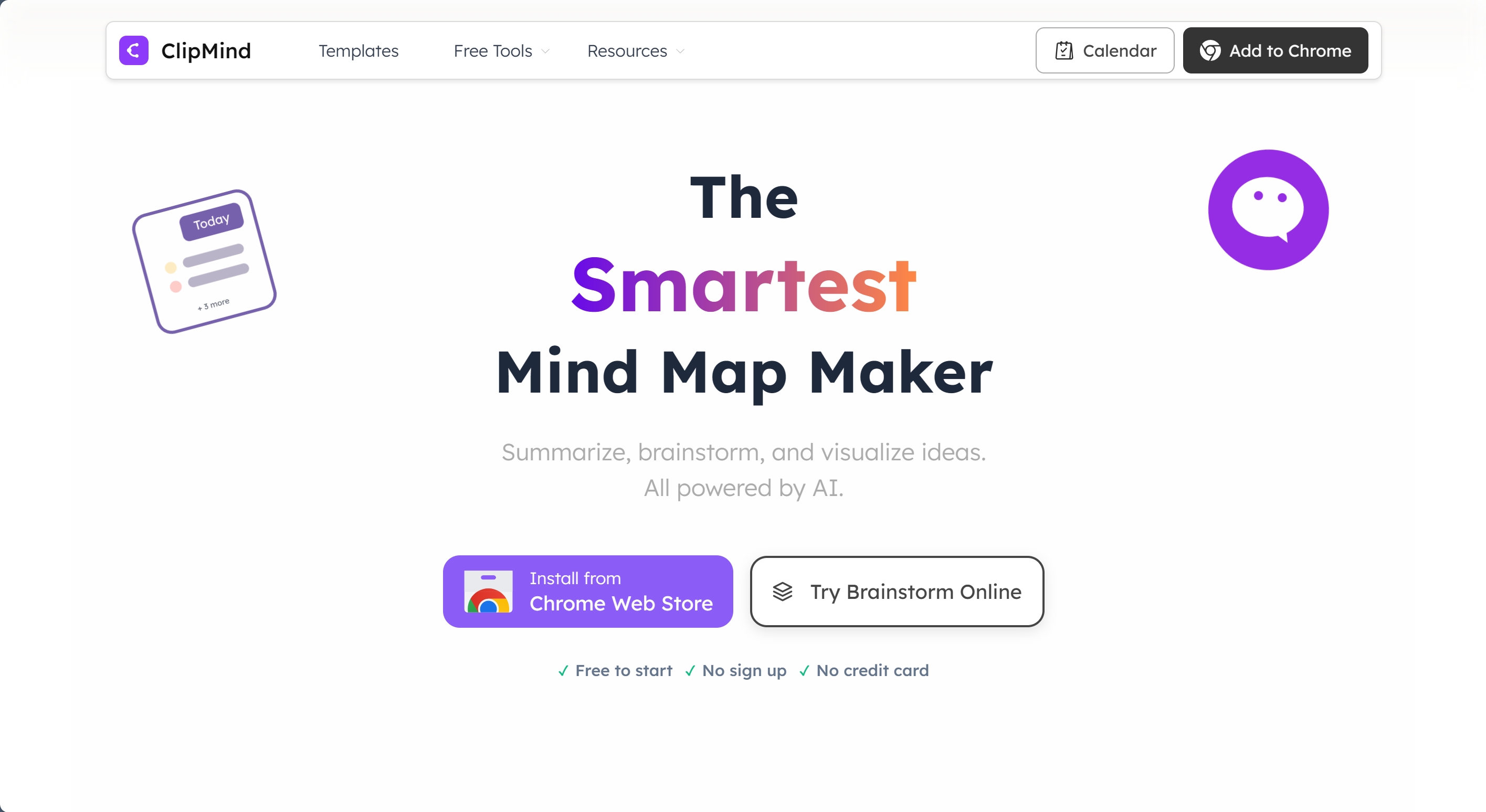
What sets ClipMind apart is its AI-powered ability to transform web content into visual mind maps by analyzing webpage structure and extracting key information. This isn't just simple text extraction—the tool actually understands content hierarchy and relationships, creating structured maps that reflect the original material's organization.
Advanced Feature Set
ClipMind's dual-view system is particularly valuable for different working styles. The mind map view provides the visual overview that helps with comprehension and memory, while the markdown view offers the structured text format that many researchers and writers prefer for actual content creation.
The tool offers eight color themes and three layout options (Mind Map, Logic Chart, and Organization), providing flexibility for different types of content. During my testing, I found the Logic Chart particularly useful for process documentation, while the traditional Mind Map layout worked best for brainstorming sessions.
Noise-Free Technology
One of ClipMind's most impressive features is its noise-free filtering. Traditional webpage summarization tools often capture irrelevant content like ads, navigation menus, and footer information. ClipMind's AI identifies and filters out this noise, focusing only on the substantive content. This alone can save 15-20 minutes of manual cleanup per research session.
Privacy-First Approach
In an era of increasing data concerns, ClipMind's privacy-focused design is noteworthy. The tool requires no login, collects no personal data, and processes content locally on your device. This makes it ideal for sensitive research, proprietary business information, or any situation where data privacy is paramount.
ClipMind Strengths and Limitations
Key Advantages
- Instant AI Summarization: Transform any webpage into an editable mind map with one click
- Unlimited Free Exports: Save maps as SVG or Markdown without restrictions—a rarity among free tools
- Privacy-Focused: No account required, no data collection, content stays on your device
- Multiple Themes & Layouts: Eight color presets and three structural layouts for different needs
- Dual-View System: Switch between visual mind map and structured markdown views
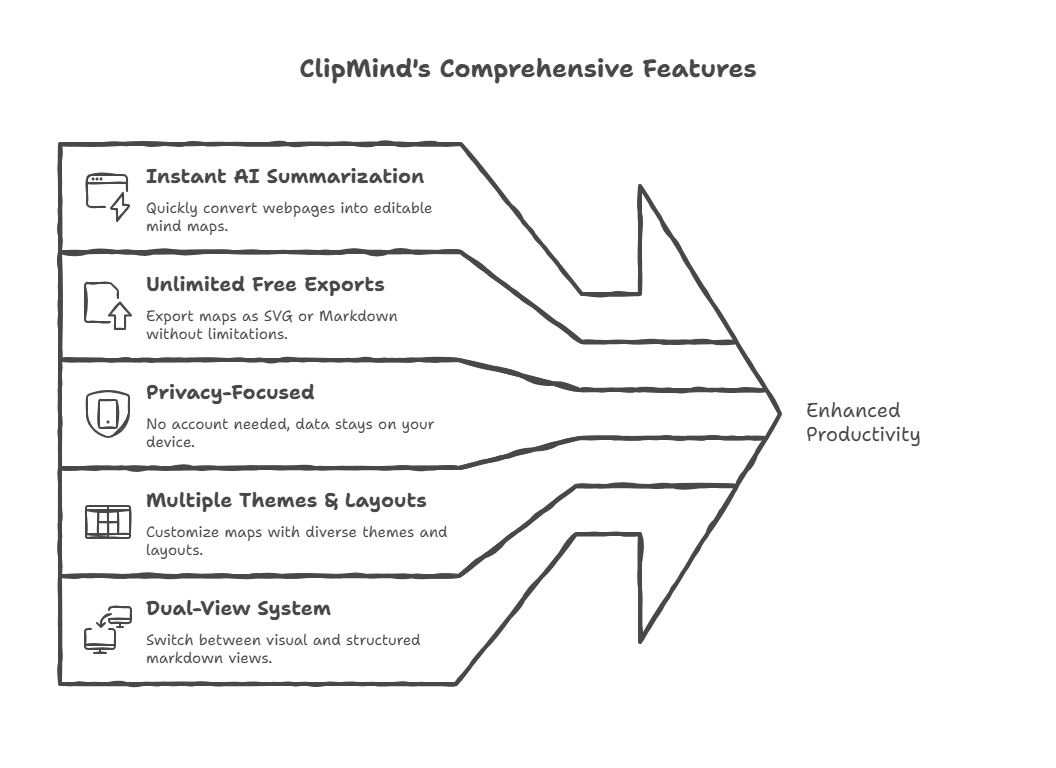
Current Limitations
- Chrome Extension Only: Currently limited to browser-based use without standalone desktop or mobile apps
- No Real-Time Collaboration: Designed for individual use rather than team editing
- Text-Focused: Best for web content and text-based materials rather than visual brainstorming from scratch
Ideal Use Cases
Based on my testing, ClipMind works exceptionally well for:
- Academic researchers summarizing papers and articles
- Content creators organizing research for blog posts or videos
- Students creating study guides from online materials
- Professionals who need to quickly digest and organize web-based information
- Anyone working with sensitive content who values privacy
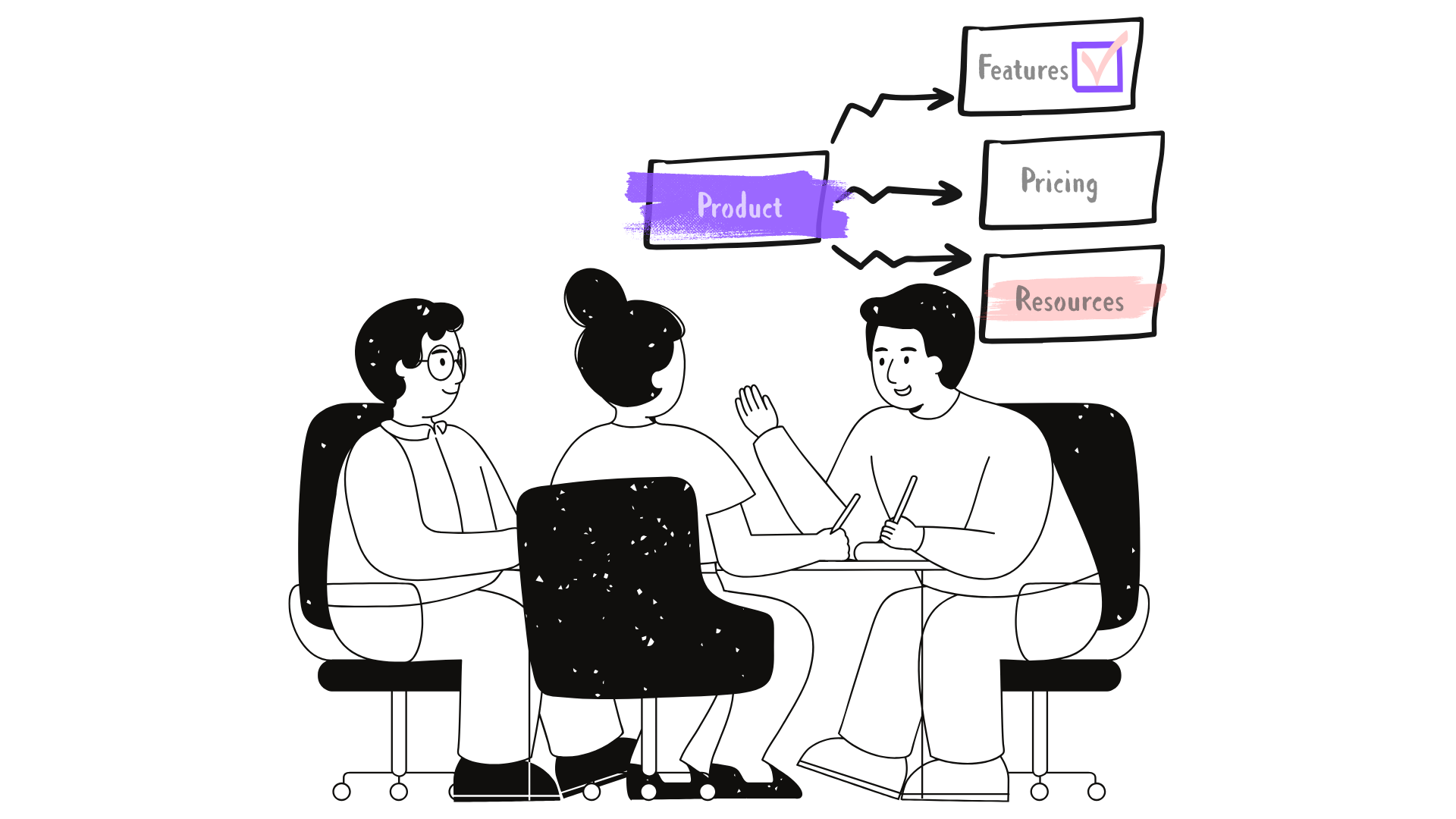
Deep Dive: XMind - Traditional Mind Mapping Powerhouse
Desktop-Focused Excellence
XMind has been a staple in the mind mapping community for years, and for good reason. Its desktop-focused approach provides stability and performance that web-based tools sometimes lack. During my testing, I appreciated how quickly I could create complex maps without worrying about internet connectivity or browser performance issues.
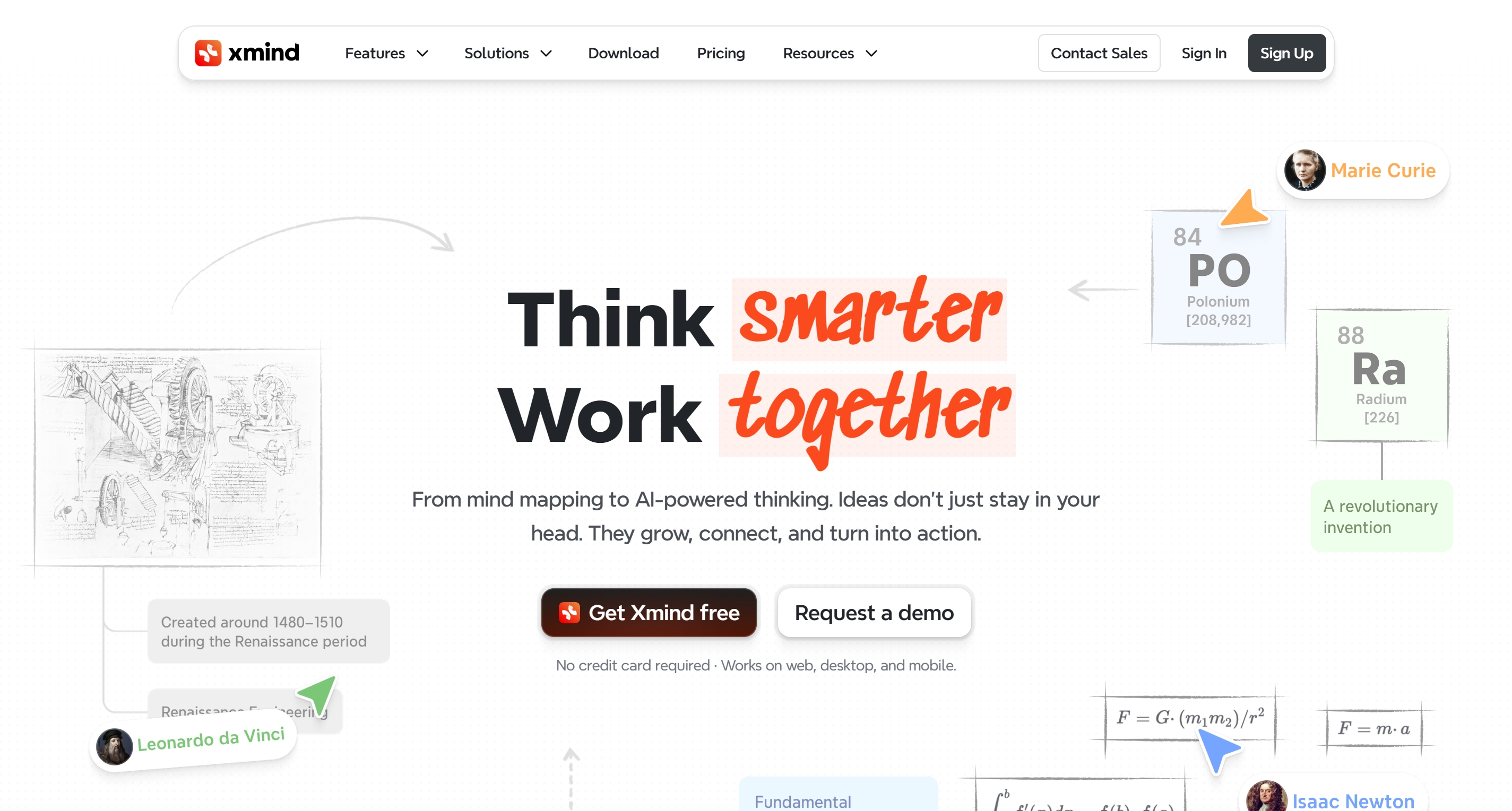
The tool offers an extensive template library that goes beyond traditional mind maps to include balance maps, matrix structures, and timeline views. This versatility makes it suitable for everything from simple brainstorming to complex project planning and strategic analysis.
Professional Output Quality
Where XMind truly shines is in the professional quality of its outputs. The maps look clean, polished, and presentation-ready—something that's particularly important for business users who need to share their work with stakeholders or clients. The attention to visual design details sets it apart from more utilitarian options.
However, this professional quality comes with limitations in the free version. Exports include watermarks, which can be problematic for professional use. The free version also limits theme options, restricting your ability to fully customize the visual appearance of your maps.
XMind Strengths and Limitations
Core Strengths
- Extensive Templates: Wide variety of map types and structures beyond basic mind maps
- Professional Output: High-quality visuals suitable for business presentations
- Multiple Diagram Types: Support for timelines, matrices, and organizational charts
- Desktop Stability: Reliable performance without internet dependency
- Mature Ecosystem: Well-established tool with extensive community resources
Free Version Limitations
- Watermarked Exports: All free version exports include XMind branding
- Limited Themes: Restricted customization options in the free plan
- Desktop-Focused: Less convenient for users who need cross-device access
- No AI Features: Lacks the intelligent summarization of newer tools
Best Use Scenarios
XMind excels for:
- Business professionals creating presentation materials
- Consultants developing strategic frameworks and analyses
- Educators preparing teaching materials and lesson plans
- Users who prefer desktop software over web-based tools
- Anyone needing multiple diagram types beyond basic mind maps
Deep Dive: MindMeister - Collaborative Online Mind Mapping
Team-Centric Design
MindMeister takes a fundamentally different approach from tools like ClipMind and XMind by focusing primarily on collaboration. As someone who's facilitated remote brainstorming sessions, I can attest to the value of real-time collaborative features when working with distributed teams.
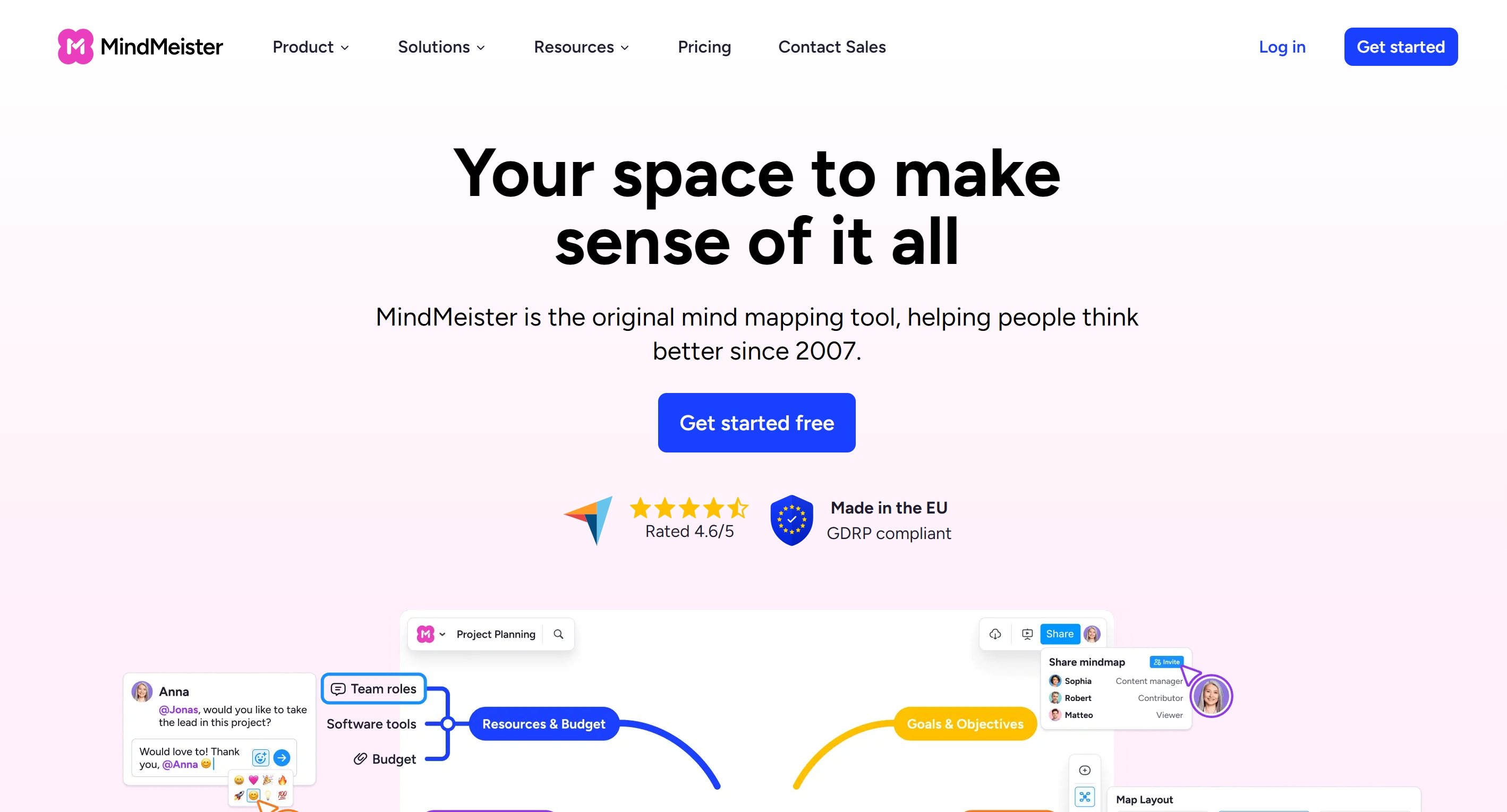
The tool enables multiple users to edit mind maps simultaneously, with changes appearing instantly for all participants. This creates a dynamic brainstorming environment that closely mimics in-person collaboration. The commenting and voting features further enhance the collaborative experience, making it easy to gather feedback and build consensus.
Integration Ecosystem
MindMeister's integration with MeisterTask transforms it from a simple brainstorming tool into a comprehensive project management solution. You can convert map nodes into actionable tasks with assignments, due dates, and progress tracking. This workflow is particularly valuable for project managers who need to bridge the gap between ideation and execution.
However, the free version imposes significant limitations that can quickly become frustrating. The restriction to only three mind maps means you'll constantly be archiving or deleting old maps to create new ones. The export options are also quite basic, limiting your ability to use the maps outside the MindMeister ecosystem.
MindMeister Strengths and Limitations
Collaboration Excellence
- Real-Time Editing: Multiple users can collaborate simultaneously on the same map
- Presentation Mode: Convert mind maps into engaging presentations with one click
- Task Management Integration: Seamless connection with MeisterTask for project execution
- Commenting & Voting: Built-in features for feedback and decision-making
- Web-Based Accessibility: Access from any device with internet connection
Free Plan Restrictions
- Three Map Limit: Severely restrictive for ongoing use across multiple projects
- Basic Export Options: Limited format support for saving maps externally
- Account Requirement: Mandatory sign-up unlike some privacy-focused alternatives
- No AI Features: Lacks intelligent content processing capabilities
Ideal Team Applications
MindMeister works best for:
- Remote teams needing synchronous brainstorming sessions
- Project managers coordinating ideation and task creation
- Educational institutions facilitating group projects
- Organizations that value integrated task management
- Situations where real-time collaboration trumps individual features
Hands-On Scenarios and Results
Research Paper Summarization Test
To evaluate these tools in real-world conditions, I conducted a controlled test using a 15-page academic paper on cognitive psychology. The goal was to create a comprehensive mind map summarizing the key concepts and research findings.
ClipMind processed the PDF (converted to webpage) in under 30 seconds, creating a well-structured map that accurately captured the paper's main sections and key findings. The hierarchical organization mirrored the paper's structure, and the noise-free filtering eliminated references and methodological details I didn't need for my summary.
Manual methods using XMind and MindMeister took approximately 45-60 minutes to achieve similar results. While I had more control over the specific organization and wording, the time investment was substantially higher. This aligns with research showing that systematic reviews take an average of 67.3 weeks to complete, driving interest in automated methods.
Team Brainstorming Session
For collaborative scenarios, I organized a 30-minute remote brainstorming session with a team of five participants to plan a content marketing campaign.
MindMeister excelled in this scenario, with all participants able to contribute simultaneously. The real-time updates and commenting features created an engaging, dynamic session that produced 35 unique content ideas with associated notes and priorities.
Miro also performed well with its extensive whiteboarding capabilities, though the three-board limit in the free version quickly became problematic for ongoing use.
ClipMind and XMind were unsuitable for this collaborative scenario due to their individual-focused designs.
Presentation Quality Assessment
When creating mind maps for client presentations, visual polish and export quality become critical factors.
XMind produced the most professional-looking outputs, with clean lines, balanced spacing, and attractive color schemes. The ability to create non-traditional diagram types like matrices and timelines added significant value.
ClipMind's SVG exports were surprisingly high-quality and worked well for digital presentations, though they lacked the refined aesthetic of XMind's outputs.
MindMeister's presentation mode was convenient for direct presenting but offered limited customization for exported materials.
When to Choose Each Tool: Scenario-Based Recommendations
ClipMind: The Research and Content Specialist
Choose ClipMind when your primary need involves processing existing content rather than creating from scratch. It's ideal for:
- Academic researchers summarizing papers and articles
- Content creators organizing research for writing projects
- Students creating study guides from online materials
- Professionals who frequently research competitors or industry trends
- Anyone working with sensitive information who values privacy
The unlimited free exports and AI-powered summarization make it uniquely valuable for these use cases, addressing the common challenge of webpage content extraction for mind mapping.
XMind: The Presentation Professional
Select XMind when you need polished, presentation-ready outputs and multiple diagram types:
- Business consultants creating client deliverables
- Educators developing course materials and lesson plans
- Project managers designing complex process flows
- Strategic planners analyzing multi-faceted problems
- Users who prefer robust desktop software over web tools
The extensive template library and professional output quality justify dealing with the watermark limitations for many business applications.
MindMeister: The Collaboration Champion
Opt for MindMeister when team collaboration is your primary concern:
- Remote teams conducting brainstorming sessions
- Project managers facilitating planning workshops
- Educational groups working on collaborative projects
- Organizations with distributed team members
- Situations where real-time interaction trumps individual features
The integration with task management and excellent real-time capabilities make it worth the three-map limitation for team-based work.
Alternative Options for Specific Needs
Miro works best for visual workshops and design thinking sessions where you need extensive whiteboarding beyond simple mind mapping.
Coggle offers simplicity and ease of use for basic collaborative mind mapping with a clean, intuitive interface.
FreeMind serves open-source enthusiasts and users who prefer locally installed software without any cloud dependencies.
EdrawMind provides a middle ground with decent features across multiple diagram types but significant limitations in the free version.
Conclusion and Final Recommendations
After extensive testing and real-world application, it's clear that there's no single "best" free mind mapping tool—only the best tool for your specific needs and workflow.
For individual researchers and content creators, ClipMind offers unparalleled value with its AI-powered summarization, unlimited free exports, and privacy-focused design. The ability to instantly transform web content into organized mind maps represents a significant productivity advantage that addresses the gap between content consumption and organization.
For business professionals needing polished outputs, XMind provides the template variety and visual quality that make presentations stand out, despite the watermark limitations in the free version.
For teams prioritizing collaboration, MindMeister's real-time editing and task management integration create a seamless bridge between ideation and execution, though the three-map limit requires careful management.
The key takeaway is to match the tool to your primary use case rather than trying to find one tool that does everything perfectly. Most users will benefit from having 2-3 tools in their arsenal for different scenarios: perhaps ClipMind for research, MindMeister for team sessions, and XMind for final presentations.
As AI continues to transform how we process information, tools like ClipMind that leverage intelligent content analysis will likely become increasingly valuable. The traditional distinction between content consumption and organization is blurring, and the most effective tools will be those that bridge this gap seamlessly.
Learn More
- ClipMind Chrome Extension - Install the free extension to try AI-powered webpage summarization
- Advanced Mind Mapping Techniques - Learn professional mind mapping strategies
- Research on Visual Thinking Benefits - Understand the science behind mind mapping effectiveness
FAQs
-
Can I really use these tools for free without hidden costs? Yes, all the tools discussed offer genuinely free versions, though with various limitations. ClipMind is notable for offering unlimited exports and AI features without restrictions.
-
Which tool is best for academic research? ClipMind excels for academic research due to its AI-powered summarization and ability to process complex papers into structured mind maps quickly.
-
Do any free tools offer real-time collaboration? MindMeister and Miro both offer excellent real-time collaboration features in their free versions, though with limitations on the number of maps/boards you can create.
-
Can I use these tools on mobile devices? Most web-based tools work on mobile browsers, but dedicated mobile apps vary. XMind and MindMeister have mobile apps, while ClipMind is currently Chrome extension only.
-
Which tool has the best export options for free users? ClipMind offers unlimited SVG and Markdown exports without watermarks, which is unique among free tools. Most others restrict exports or add watermarks.
-
Are there privacy concerns with free mind mapping tools? Tools that require accounts and store data in the cloud may raise privacy concerns. ClipMind stands out for its privacy-first approach with no account required and local processing.
-
Can I switch between tools easily? Most tools use proprietary formats, making direct transfers difficult. However, basic mind map structures can often be recreated manually, and some tools support standard formats like FreeMind's .mm format.
